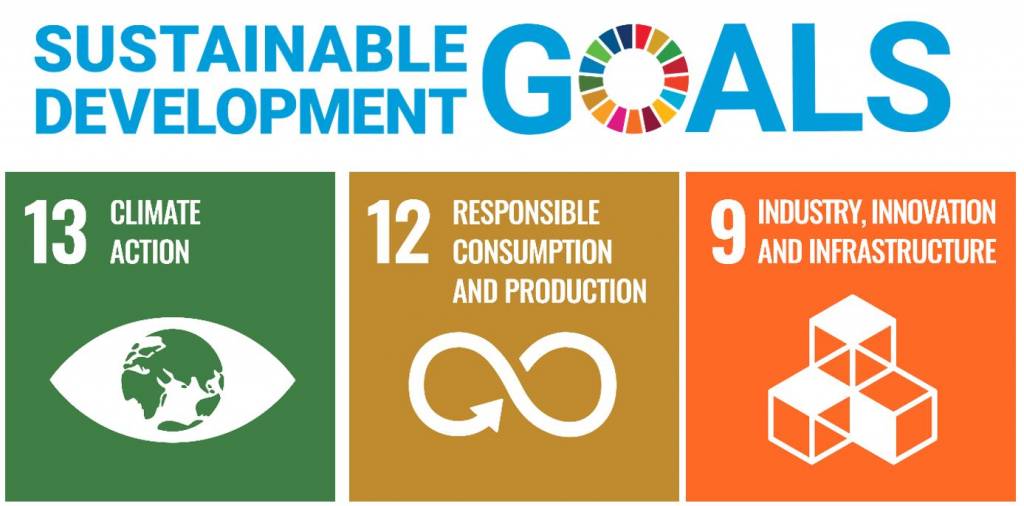In 2015, United Nations General Assembly released a Sustainable Development Agenda for 2030 [1]. It provides a shared blueprint for peace and prosperity for people and the planet, now and into the future. At its heart are the 17 Sustainable Development Goals (SDGs), which are an urgent call for action by all countries – developed and developing – in a global partnership, to achieve a better and more sustainable future for all. Many of the SDGs are also directly linked with the aims and activities of PerforMat network. The top three in importance are listed in the following together with their connection to PerforMat.
SDG13 Climate action: Take urgent actions to combat climate change and its impacts
In line with the target, Finland seeks carbon neutrality by 2035 and carbon negativity soon after that [2]. Just recently, Sitra [3] published a study concluding that achieving Finland’s climate goals in a cost-effective way requires replacing fossil fuels with clean electricity in industry, transport, and heating. In energy sector, this will mean an increase in renewable energy, particularly onshore wind, and likely also in nuclear energy, whereas fossil-free transport sector heavily relies on electrification. This also means the shift to fossil-free fuels, including hydrogen, emphasizing the importance of the interactions with materials to be known and predicted. Furthermore, in all above-mentioned areas, long and predictable lifetime of components, optimized friction between the moving surfaces in contact, or both, are essential with respect to operational reliability and energy efficiency -thus the ability to respond to the challenge of climate change. Indeed, these are the themes of the PerforMat network. Particularly tribology, via the direct relation of friction to energy consumption, is a topic that will probably gain increasing attention in the future. Among the selected four use cases of PerforMat, three are related to tribology. The fourth one focusses on hydrogen-material interactions, the topic that is also foreseen to attract plenty of effort in the years to come as, e.g., steel industry is taking a giant leap towards carbon neutrality.
SDG12 Responsible consumption and production: Ensure sustainable consumption and production patterns
The Circularity Gap Report 2020 [4] has shown that, of the total global material inputs of 100.6 billion tonnes, only 8.65 billion tonnes are cycled and kept in the raw material loop, meaning that the world is by far only 8.6 % circular. The material groups of PerforMat focus are ultrahigh-strength steels and advanced thin films and surface coatings. Metals and functional surface films are widely used in engineering applications that are included in the long-term stock, i.e., they are in use for a long time. This implies that “right materials” are selected for each type of application so that no significant degradation occurs over time. Additionally, material development occurs constantly, for example, for substituting critical raw materials or for improving the environmental compatibility (e.g., lubricants), introducing new sustainable alternatives. However, when the new materials and solutions enter the market, it is not always self-evident for which applications and components the new solutions provide the best performance. The data-centric approach of PerforMat network, integrating three essential research areas: experimental research on materials and their performance, computational multi-scale modelling and data informatics, accelerates the selection of new solutions to the right applications.
SDG9 Industry, innovation and infrastructure: Build resilient infrastructure, promote inclusive and sustainable industrialization and foster innovation
PerforMat network is funded by the Academy of Finland via RDI partnership network funding instrument that aims to support and promote the networking of higher education institutions and government research institutes with the business sector in order to boost the societal impact of high-quality research. PerforMat has a wide stakeholder network, covering large and small companies as well as associations. The network activities bring stakeholders together, generate new materials performance data that benefits the network and share the data openly, develop digital tools to enable materials acceleration to applications and establish virtual workrooms for user engagement and data utilization. It is acknowledged, e.g., [5], that roots for innovation lie, on one hand, in new knowledge and, on the other hand, in digital technologies. The PerforMat network will make both of these elements available for its stakeholder network and beyond.
Sustainable development goals challenge researchers and the entire society to go beyond state-of-the-art and unite the capacity of different stakeholders for meaningful advancements. They are also at the core of VTT’s new strategy: our purpose is to bring together people, business, science, and technology, to solve the world’s biggest challenges, creating sustainable growth, jobs and wellbeing.

Authors
Elina Huttunen-Saarivirta, Helena Ronkainen, Vuokko Heino, Elisa Isotahdon, VTT Technical Research Centre of Finland Ltd
References
- https://sdgs.un.org/2030agenda
- https://ym.fi/en/climate-neutral-finland-2035
- https://www.sitra.fi/en/publications/enabling-cost-efficient-electrification-in-finland/
- https://www.circularity-gap.world/2020
- https://www.oecd-ilibrary.org/docserver/9789264239814-en.pdf?expires=1633431082&id=id&accname=ocid46013614&checksum=E659357006394B16EBB5CB9ACA3E4F09

